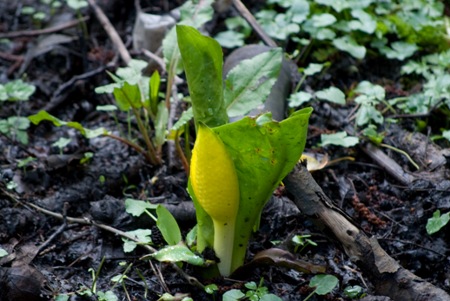
Michelle Salter writes:
Whilst other flowers are making a later appearance than last year, there’s no stopping the return of the robust Skunk Cabbage.
The yellow flowers of Lesser Celandine are only just starting to show on the banks of the Brookly Stream, and the Easter flower, Wood-sorrel has yet to appear on the path to Sandy Bay. But the large, yellow, waxy flowers of American Skunk Cabbage are starting to pop up all around the pond.

While most wildflowers need the warmth of the spring sun before they bloom, the Skunk Cabbage generates its own heat, which is strong enough to melt small patches of surrounding snow. The largest colony of Skunk Cabbage at the pond can be found by Brookly Stream as they formed part of the private garden that became Brookly Wood.
American Skunk Cabbage was introduced to this country around 1900, when it became a popular addition to many gardens. It has since spread as a naturalised plant in marshy areas. Its strong odour attracts flies, gnats, and bees necessary for its pollination.
American Skunk Cabbage has been listed as a species that can be invasive, but as yet its impact is unknown. The wet woodland it favours is a rare and vulnerable habitat and the forceful Skunk Cabbage can crowd out other plants.
A project has been launched to record and count invasive species that can have a destructive effect on native wildlife, and members of the public are asked to take part by taking photos and submitting them to the GB Non-Native Species Secretariat (NNSS) website.
Recording Invasive Species Counts (RISC)
The Recording Invasive Species Counts (RISC) project is a way to find out more and to contribute to our understanding of the distribution and ecology of six invasive non-native species. It is co-ordinated by the NBN and BRC (part of the Centre for Ecology & Hydrology), in partnership with recording schemes for the animals and plants. The project is funded by Defra.
Photo credits: Michelle Salter
